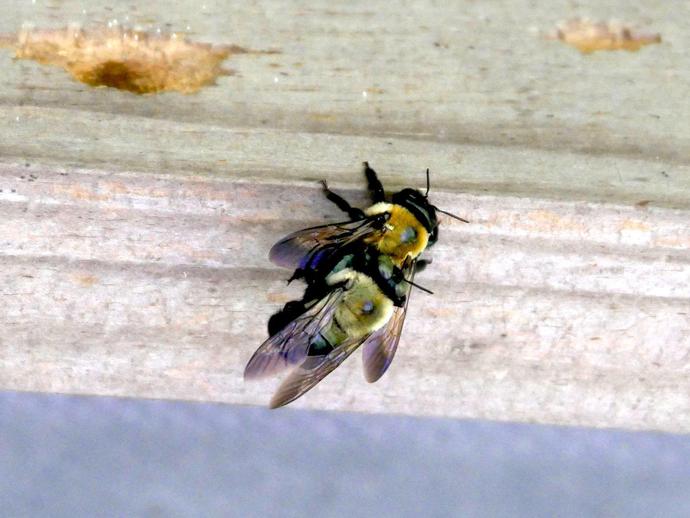April 12, 2020
Here we see two eastern carpenter bees (Xylocopa virginica), photographed in flagrante delicto. If you've ever wondered how to tell the difference between a carpenter bee and a bumble bee, it's actually pretty easy: Carpenter bees have shiny black abdomens, while bumble bee abdomens are covered in fuzz.
Carpenter bees build their nests in wood, and they especially prefer milled pine and cedar lumber. The nests are either solitary or social, with either one female or several females nesting together. Carpenter bees have a loose social structure; if several females are nesting together, there will be a dominant female that is charge of laying eggs and providing food for the larvae, followed by secondary females that maintain the nest and provide food, followed by tertiary females that just sort of hang around and don't do much. The dominant females are usually bees that have overwintered more than once. It's believed that this loose social group may be an evolutionary step toward the much more complex social hierarchies that we see in honeybees.
Eastern carpenter bees don't actually eat the wood that they nest in; they survive on nectar and pollen. As a result, they're important pollinators, though they mostly visit wild or decorative plants, so they're not major agricultural pollinators.
If you ever have a carpenter bee buzzing aggressively around your head (because you got too close to its nest), don't panic: the males can't sting at all, and the females only sting if they're roughly handled. You can easily tell the difference between male and female carpenter bees; males have a white spot on their faces, while females do not.
Unfortunately, because carpenter bees build their nests in wood, they can be pretty destructive. As you can see from the photo, the carpenter bees at my house are slowly destroying my porch, probably so it will collapse on me and they can collect the insurance payout. As frustrating as their damage can be, the good that carpenter bees do far outweighs the bad, and we should leave these important pollinators alone whenever possible. #BenInNature
About this post: Social distancing can be difficult, but the next few weeks present a great opportunity to become reacquainted with nature. While he is working from home, Administrator of Science Ben Williams is venturing outdoors each day to record a snapshot of the unique sights that can be found in the natural world.
This post brought to you by VMNH Corporate Supporter Bassett Furniture.

 Hours & Admissions
Hours & Admissions Directions
Directions

